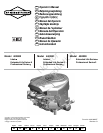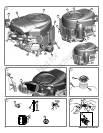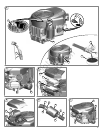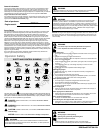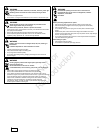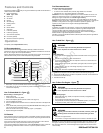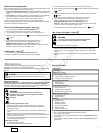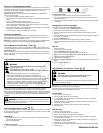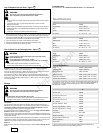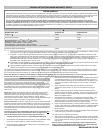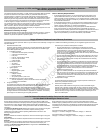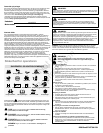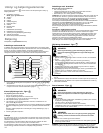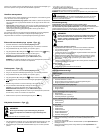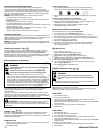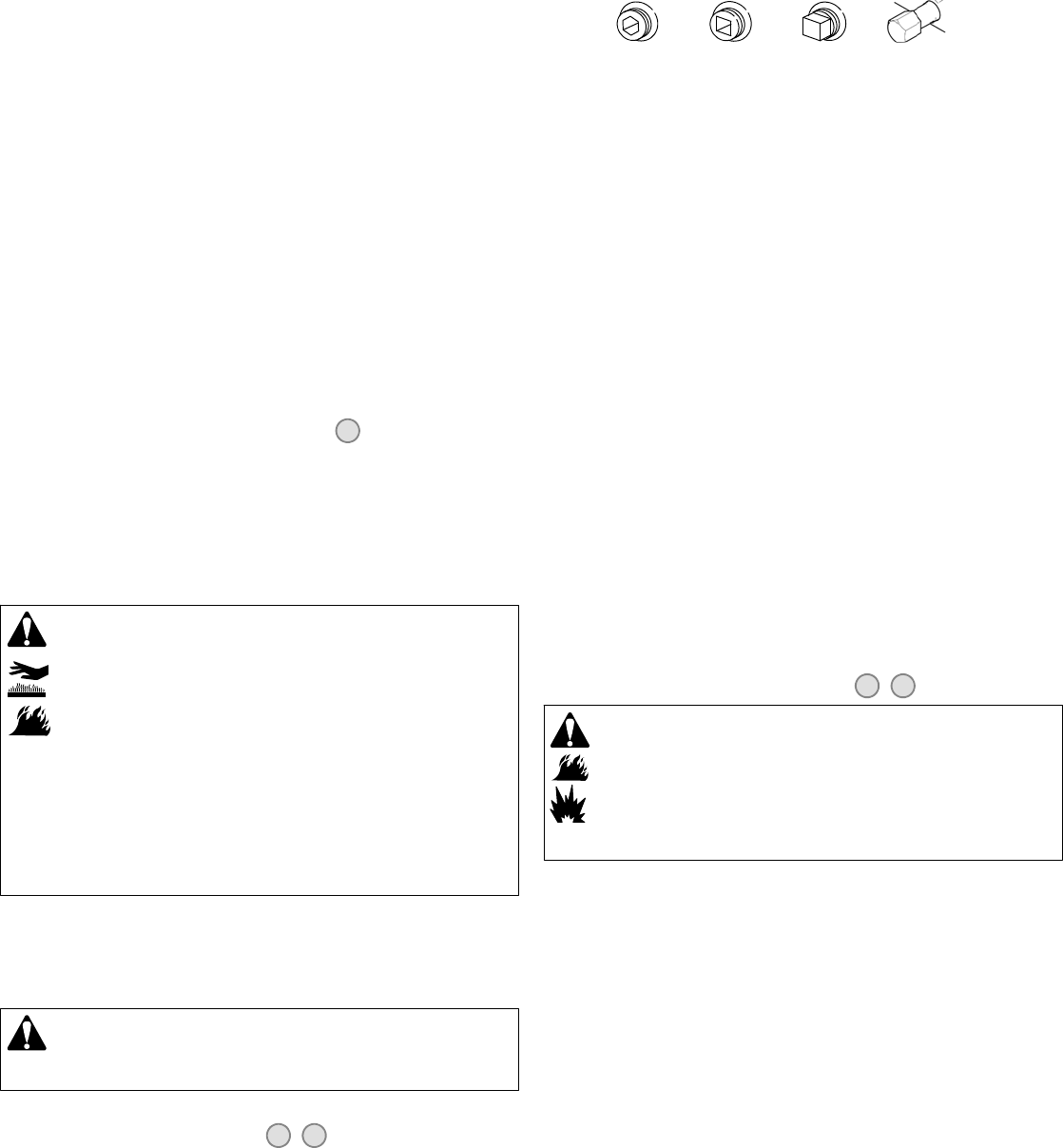
8
BRIGGSandSTRATTON.COM
Electronic Fuel Management System
The Electronic Fuel Management System monitors engine temperature, engine speed,
and batteryvoltage toadjust the chokeduring enginestarting andwarm up.There areno
adjustments on the system. If starting or operation problems occur, contact an
Authorized Briggs & Stratton Dealer.
NOTICE: Make sure to follow the steps below or the Electronic Fuel Management
System could be damaged.
Never start the engine if the battery cables are loose.
Turn the key to the off position before disconnecting, removing and/or installing the
battery.
Never use a battery charger to start the engine.
Never disconnect the battery cables while the engine is running.
When connecting the battery cables, first connect the positive (+) cable and then
connect the negative (--) cable to the battery.
When charging the battery, turn the ignition switch to the off position and disconnect
the negative (--) battery cable from the battery.
Do not spray water directly on the Electronic Control Unit.
Carburetor Adjustment
Never make adjustments to the carburetor. The carburetor was set at the factory to
operate efficiently under most conditions. However, if adjustments are required, see a
Briggs & Stratton Authorized Dealer for service.
NOTICE: The manufacturer of the equipment on which this engine is installed specifies
the top speed at which the engine will be operated. Do not exceed this speed.
How To Replace The Spark Plug - Figure
5
Check the gap (A, Figure 5) with a wire gauge (B). If necessary, reset the gap. Install
and tightenthe sparkplug totherecommended torque.For gap settingor torque,see the
Specifications section.
Note: In some areas, local law requires using a resistor spark plug to suppress ignition
signals. If this engine was originally equipped with a resistor spark plug, use the same
type for replacement.
Inspect Muffler And Spark Arrester
Running engines produce heat. Engine parts, especially muffler,
become extremely hot.
Severe thermal burns can occur on contact.
Combustible debris, such as leaves, grass, brush, etc. can catch fire.
WARNING
Allow muffler, engine cylinder and fins to cool before touching.
Remove accumulated debris from muffler area and cylinder area.
It is a violation of California Public Resource Code, Section 4442, to useor
operate the engineon anyforest-covered,brush-covered,or grass-covered land
unless the exhaust system is equipped with a spark arrester, as defined in
Section 4442, maintained in effective working order. Other states or federal
jurisdictions may have similar laws. Contact the original equipment
manufacturer, retailer, or dealer to obtain a spark arrester designed for the
exhaust system installed on this engine.
Exhaust system parts are installed by the equipment manufacturer. For specific
maintenance and replacement information, contact the equipment manufacturer.
Remove accumulated debris from muffler area and cylinder area. Inspect the muffler for
cracks, corrosion, or other damage. Remove thes park arrester, if equipped, andinspect
for damage or carbon blockage. If damage is found, install replacement parts before
operating.
WARNING: Replacement parts must be of the same design and installed
in the same position as the original parts. Other parts may not performas well, may
damage the unit, and may result in injury.
How To Change The Oil - Figure
6 7
Used oil is a hazardous waste product and must be disposed of properly. Do not discard
with householdwaste. Check with yourlocal authorities,service center, or dealerfor safe
disposal/ recycling facilities.
Remove Oil
1. With engine off but still warm, disconnect the spark plug wire (A) and keep it away
from the spark plug (Figure 6).
2. Remove the dipstick (D).
Standard Oil Drain Plug
1. Remove the oil drain plug (B). Drain the oil into an approved container.
Note: Any of the oil drain plugs shown below may be installed in the engine.
2. After the oil has drained, install and tighten the oil drain plug.
Optional Quick Oil Drain
1. Disconnect the oil drain hose (G, Figure 6) from the side of the engine.
2. Turn and remove the oil drain cap (H). Carefully lower the quick oil drain (I)intoan
approved container (J).
3. After the oil has drained, install the oil drain cap. Attach the oil drain hose to the side
of the engine.
Change The Oil Filter (if equipped)
For replacement intervals, see the Maintenance chart.
1. Drain the oil from the engine. See Remove Oil section.
2. Remove the oil filter (C) and dispose of properly. See Figure 7.
3. Before you install the new oil filter, lightly lubricate the oil filter gasket with fresh,
clean oil.
4. Install the oil filter by hand until the gasket contacts the oil filter adapter, then tighten
theoilfilter1/2to3/4turns.
5. Add oil. See Add Oil section.
6. Start and run the engine. As the engine warms up, check for oil leaks.
7. Stop the engine and check the oil level. It should be at the FULL mark on the
dipstick.
Add Oil
Place engine level.
Clean the oil fill area of any debris.
See the Specifications section for oil capacity.
1. Remove the dipstick (D) and wipe witha clean cloth (Figure 6).
2. Pour the oil slowly into the engine oil fill (E). Do not overfill. After adding oil, wait
one minute and then check the oil level.
3. Install and tighten the dipstick.
4. Remove the dipstickand check the oil level. It should beat the FULL mark(F)onthe
dipstick.
5. Install and tighten the dipstick.
How To Service The Air Filter - Figure
8 9
WARNING
Fuel and its vapors are extremely flammable and explosive.
Fire or explosion can cause severe burns or death.
Never start or run the engine with the air cleaner assembly (if equipped) or the
air filter (if equipped) removed.
NOTICE: Do not use pressurized air or solvents to clean the filter. Pressurized air can
damage the filter and solvents will dissolve the filter.
The air filter system uses either a flat or oval cartridge. Some models are also equipped
with a pre-cleaner that can be washed and reused.
Flat Air Filter
1. Remove the cover (A, Figure 8).
2. Remove the filter (C) and the pre-cleaner (B).
3. To loosen debris, gently tap the filter on a hard surface. If the filter is excessively
dirty, replace with a new filter.
4. Wash the pre-cleaner in liquid detergent and water. Then allow it to thoroughly air
dry. Do not oil the pre-cleaner.
5. Assemble the dry pre-cleaner and the filter into the engine base (D).
6. Install the cover.
Oval Air Filter
1. Remove the cover (A, Figure 9).
2. To remove the filter (B), lift the end of the filter.
3. Remove the pre-cleaner (C), if equipped, from the filter.
4. To loosen debris, gently tap the filter on a hard surface. If the filter is excessively
dirty, replace with a new filter.
5. Wash the pre-cleaner in liquid detergent and water. Then allow it to thoroughly air
dry. Do not oil the pre-cleaner.
6. Assemble the dry pre-cleaner to the filter.
7. Install the filter into theengine base (D) and pushdown until the filter snapsin place.
8. Install the cover.
Not for
Reproduction



